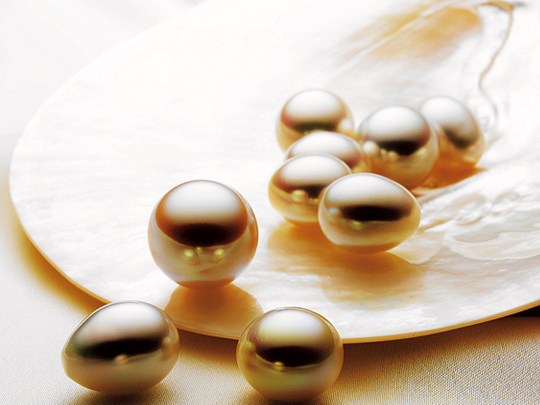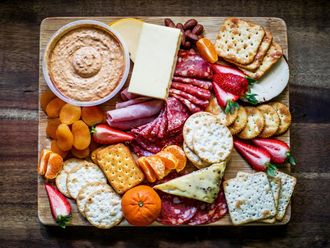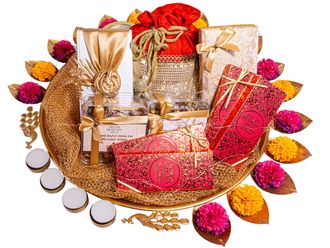
"Last thing on, first thing off," says Stephen Francis, retail regional manager of Paspaley Pearls Pty Ltd, speaking of the most important rule for wearing pearl jewellery. He says chemicals from make-up, perfume or hair products may harm the pearls - gifts from nature that aren't enhanced artificially.
These pointers on caring for pearl jewellery are just a few of the aspects covered by Francis at the Pearl Appreciation Experience at the Dubai Mall Paspaley boutique. The company, which celebrated its 75th anniversary last year, is one of the leading pearl companies worldwide with clients including Tiffany & Co, Cartier and Harry Winston.
Read more...
Things to know before you buy pearls
Pearls of wisdom: Facts about pearls
At the boutique, Francis talks through farming processes and judging pearl quality. Although selecting pearls is based on preference, he says it is important to know how to assess pearls. "Lustre, complexion, shape, size and colour contribute to quality. At Paspaley, these characteristics are referred to as virtues." But first, he expounds on the pearling industry and cultured pearls in jewellery.
The basics: what is a pearl?
A pearl is a gift from the sea created by the mollusc family, which includes oysters, clams, scallops and mussels, but only a few can produce beautiful pearls. If a foreign object settles inside an oyster, for instance, the mollusc takes defensive action to ease the irritation by producing an iridescent substance called nacre, enveloping the foreign object and crystallising around it. This could lead to a pearl. Today, most of the world's natural pearl-producing oyster beds have vanished due to over-fishing and marine pollution. Natural pearls are almost non-existent, especially large varieties. Those looking for pearls, look for cultured pearls.
So cultured pearls aren't natural?
Cultured pearls require human assistance to insert a natural irritant - mostly organic - into the oyster, after which nature takes over. Despite the advances of science, it is nature that determines whether there will be a pearl at all, and if so, whether it will be beautiful and valuable.
At Paspaley, highly skilled technicians delicately implant a foreign organic body we call a nucleus. From the moment this is done, the oyster begins its natural function of covering nacre around the nucleus. The oyster is then returned to the sea for its cultivation period where it spends two years coating the nucleus with layers of nacre that form the pearl. This is a critical period during which the oyster needs constant attention, care and cleaning to help it thrive and produce a beautiful pearl. The more layers of nacre, the more beautiful the pearl.
Is there more to this classification of pearls?
Both natural and cultured pearls are divided into two broad categories - freshwater and saltwater. Most cultured pearls belong to the saltwater category; freshwater pearls are considered to be the ‘odd man out' as they aren't produced by the common saltwater Pinctada family of pearl oysters. In fact, they aren't produced by oysters at all. For instance, in China freshwater mussels such as the Hyriopsis cumingii and Cristaria plicata are used; each shell can produce up to 100 pearls simultaneously, resulting in very low prices for pearls. Furthermore, freshwater pearls such as Japanese Akoya aren't marketable for jewellery in their natural state and require artificial enhancements such as bleaching, colouring and polishing. In general, saltwater pearls are more valuable than freshwater pearls.
Why are saltwater pearls more valuable?
The nacre of pearl oysters is far more lustrous than clamshell nacre. Generally, the most beautiful molluscs - such as the oysters of the Pinctada family - produce the most beautiful pearls. Saltwater pearls are durable as they do not deteriorate when removed from the oyster, whereas freshwater pearls deteriorate quickly once removed from the clam. The most precious saltwater pearls are at the height of their beauty the moment they are removed from the mother oyster, while almost all freshwater pearls require months of chemical processing to acquire the beauty required for jewellery.
The Paspaley South Sea pearl oyster - the giant silver lip and gold lip Pinctada maxima - is the largest and rarest of all pearl oysters, prized for its famous thick shell of lustrous mother-of-pearl. (It can be reseeded up to three times but will only produce two pearls.) These produce the finest quality pearls in the world.
What determines a good quality pearl?
The finest quality cultured pearls usually require a cultivation period of two to three years so that the nucleus acquires a thick enough nacre coating for deep and lasting beauty.
There is no way to anticipate the magnitude or the quality of a particular pearl crop until it is harvested. Neither can one predict the outcome or assure that future pearl harvests are better or as good.
What marine factors influence the cultivation process of pearls?
The origin of the pearl is incredibly important and all matters of the oysters' environment will affect the pearl. Environmental conditions such as nutrients in the water; weather; water temperature; tides; and natural disasters like earthquakes and typhoons have a profound affect on the outcome.
At Paspaley, we operate under a Pearling Code of Practice that promotes policies and procedures designed to minimise environmental impact.
In the pecking order of jewellery, what value is placed on pearls?
Among all precious gems, pearls remain unsurpassed. Unlike diamonds, rubies, sapphires or emeralds, its beauty shines naturally without any cutting or polishing. The worldwide jewellery market is dominated by gold, silver, and diamonds with pearls representing only 2 per cent in value of total jewellery sales. Cultured South Sea pearls account for barely 1 per cent in volume of the global production of all cultured pearls, yet they account for nearly one third of the value.
Tell us about the renowned Paspaley South Sea pearl strands.
No two South Sea pearls are the same. Hence, only a small percentage of the annual pearl crop can be made into strands. They may vary in length from short choker styles to long opera ropes and in shape from the traditional rounds to semi-rounds, ovals, baroques and semi-baroques, among others.
Unlike the assembly factories for treated pearls, every South Sea necklace is painstakingly assembled by hand. The task is extremely demanding and is accomplished by experienced pearl graders who select each pearl to ensure that all of the five virtues - lustre, complexion, shape, size and colour - are matched. Then, each pearl is assessed for drilling, which must be done by hand. Finally each strand is crowned with an appropriate clasp. Thousands of pearls are required to assemble a single strand of 30 or so pearls; some strands have taken a decade or more to assemble.
A few pointers on caring for pearl jewellery?
Like any precious heirloom, pearl jewellery requires care to preserve its natural beauty, starting with the way you wear it. Put on your pearl jewellery after you finish applying make-up and other cosmetics, including perfume. Before putting pieces away, wipe the pearl jewellery softly with a clean cloth.
Occasionally, clean the pearls with a soft cloth dipped in mild soapy water. Then rinse the cloth in fresh water and wipe the pearl clean. Dry with a soft cloth. For storage, keep the pearl jewellery wrapped in a soft cloth, protected from abrasive objects.












